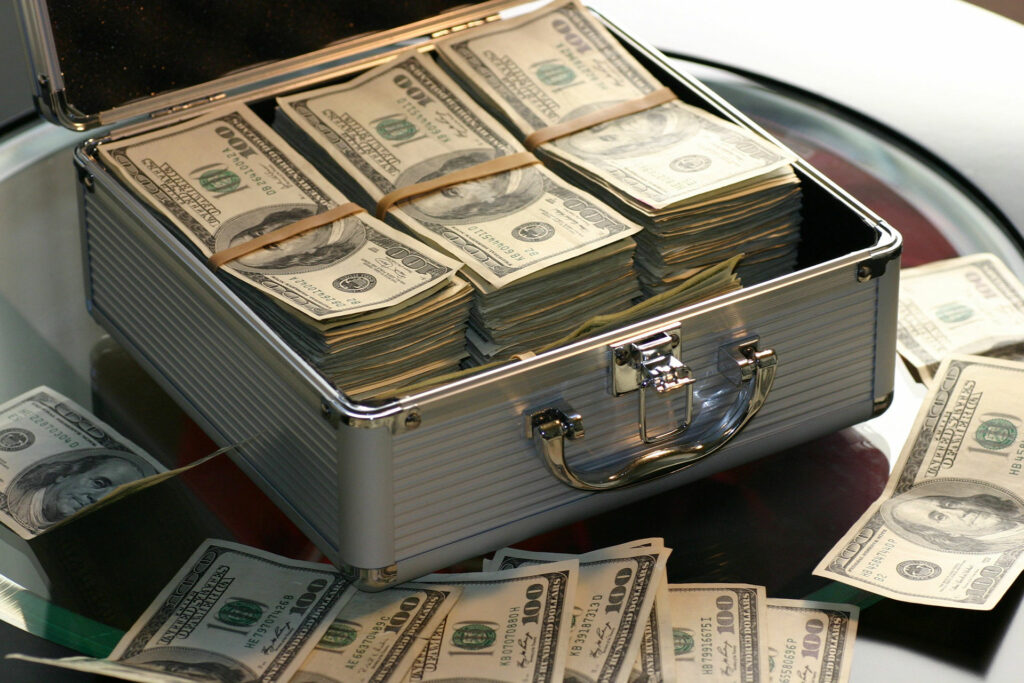Unless you are into sports like golf or polo as your pastime, the audiophile hobby is one of the more expensive ways that you can spend your discretionary dollars. While audiophiles like you and I are always looking for those excellent values in the marketplace, the best of the best often costs a pretty penny. It seems like every step in our audiophile journey is one that comes with significant cost. Today, those financial barriers to entry come at a time when inflation has returned with a vengeance, even is 2023. It was pretty modest in overall terms, but consider the roughly 3.3 percent yearly inflation is on top of 2022’s almost 10 percent price increases. It is safe to say by anybody’s measure that audiophile gear is expensive, but don’t tell me or any of my audiophile friends to stop investing in our systems, because we are not going to do that. The buzz that comes from a good audiophile upgrade is still too much fun to resist. The question is: how do we save up for that next upgrade in creative yet responsible ways? We’ve got some ideas for you to consider.

Learn a Proven Way to Become a Millionaire One Dollar at a Time
David Vaughn is a friend of mine who I met when I bought the defunct forum, HomeTheaterSpot.com, back in 2009. Despite being an occasional equipment reviewer for Sound + Vision magazine, David is a movie enthusiast who collects films archived on various formats of silver discs. Some are DVDs. Others are HD-DVDs, Blu-rays, or even Ultra-HD Blu-ray discs. At this point, I think David is rocking over 3,000 silver discs in his collection, but that number pales in comparison to how many movies that David has acquired from the seven main Hollywood studios over the years. Simply put, David can’t review everything that the studios (and now the streaming companies) put out and send him. He donates some discs that he can’t (or doesn’t want to) review to charity. He sells others on eBay.com, and for the ones that he sells, he often generates small sums of money from his recycling efforts. The studios don’t really mind because David always sends in a “tear sheet” to show the publicists what he has been able to review and he gets them lots of ink in any given year without them having to follow up. It is a rock solid, win-win relationship with far-reaching benefits.
Over the years, David diligently stashed away these tiny increments of money and invested it carefully. The result was being able to pay for his daughter to attend UCLA without her having to take on any student loan debt. This is a blessing that so many young people today don’t get to enjoy, but David delivered in spades for his daughter. In the spirit of “the branch doesn’t fall far from the tree,” his daughter networked with me, and I learned that she is a woman in tech and tech PR. That’s how my wife got started in her career, so I set up a lunch for the two of them when my wife was a “Level 7” (a “VP” outside of Bezos-world) at Amazon Studios in the marketing division. While Amazon was a brutal place to work (a well-documented fact), my wife was able to help David’s daughter get in with the human resources people at her next company, which is a publicly-traded cyber security company, and guess what? They hired her and have even promoted David’s daughter, as she has excelled in her chosen roles with the company. Today, she’s living well in Los Angeles, married and gainfully employed. Branch Rickie, the former commissioner of baseball in the 1950s, is famous for saying “luck is a residue of design,” and David designed this situation to potentially have a good outcome, and that is in fact what has happened over the years.
What if we took this successful and diligent savings model, and applied it to our audiophile system and its never-ending need for often capital-dependent upgrades? I know somebody from my early days as an audiophile teenager who did this and his system ended up fantastically amazing today.

Bridge Tolls and Travel Expenses Quietly Add Up to Real Audiophile Upgrades
Growing up, my childhood best friend’s Dad was an audiophile. This was in the 1980s and into the early 1990s, and he had a taste for audiophile equipment from the U.K. And he liked the good stuff, too, such as Naim and Linn, as well as Bowers & Wilkins. While Mr. Longo was more about the music (classical almost exclusively) than the audio, he did appreciate a fine audiophile playback system.
To this day, I will never forget going to pick up my friend Dad’s Nakamichi Dragon tape deck at the stereo store. To this day, I want one for my system if for no reason other than nostalgia, based around the good feelings that we got from picking up and exploring an outrageously exotic $2,500 cassette tape deck back in 1985. Not long after going strong in the tape deck category, Mr. Longo also invested in products that were not too hard to upgrade, such as a Linn LP-12 turntable and various Naim electronics. Linn has made their turntables amazingly upgradable over the decades, which just adds and adds to their long-term audiophile value. Naim electronics back in that era were configured so that you could add more and more power reserves and/or power supplies, which made real-world, big-time audiophile sonic differences. There were potential upgrades all over the place for this OG original audiophile.
How did he afford it all? Still to this day in his early 80s, he’s an attorney based in Philadelphia. Before his long-standing current role, he worked for a firm in Camden, New Jersey, which isn’t too terribly far from where we all lived in an idyllic part of Philadelphia. He had to do a little bit of travel for work, and he also got reimbursed by his past firm for bridge tolls. He thus took those reimburment checks and stashed that money away into his “secret” audio account. The actual money for the bridge tolls between Pennsylvania and New Jersey came out of his pocket cash or lunch money, as the money for the bridge tolls actually added up, so that he was able to make a respectable upgrade every six to 12 months, while still buying 25 to 50 Compact Discs per month.
In a similar way, small increments of money added up for both of these men, so that much larger and much more meaningful upgrades in the AV world were possible. David’s silver disc collection is truly epic today. Mr. Longo’s audio system is about as good as he could ever justify, and he’s got more physical media than most audiophiles, times five or even 10.

Borrowing Money is the Opposite of Saving It for Audio
We talked about inflation earlier, and when it comes to consumer debt or even what used to be low-interest rate home equity loans, this is a tough place to finance your audiophile upgrades at 20, 21 or 22-plus percent interest. Take it from this entrepreneur in the modern era, that business class ticket to Munich (no, I am not flying 13.5 hours in coach) tends to run the old credit card up in ways that this 49-year-old has never experienced in terms of compounded interest. Before COVID, money was closer to free in terms of interest rates, thus credit cards weren’t that brutal to use. Today, borrowing money at the consumer level via credit cards is simply brutal and not recommended, unless there is the possibility of additional gains on top of your expense (like meeting new clients at a trade show), but spending money that you don’t have on hand at 20-plus percent isn’t advisable for a purchase for your hobby.
Creatively, saving your pennies is a far better and surprisingly fast way to build an audiophile financial war chest. Borrowing money at a historically high rate as compared to much of the decade before us is spending extra money that likely should get spent. There are still banks floating zero percent offers and, if that can work in your budget, that’s not a bad way to go if you have an irresistible audiophile purchase option. Otherwise, you are better off sticking with your current budget and/or holding off on any big upgrades until you’ve got all of the money needed ready to go. This way you can still spend on your favorite points credit card (personally, I like Capital One because you get 2x miles for every dollar spent, no matter what you buy, thus your points add up pretty fast) and win on both fronts, but there are a number of good points cards out there for those who have a respectable FICO score and are willing to spend a few hundred dollars on fees.
Look to Venues eBay.com and Audiogon.com to Add Bigger Chunks of Money to Your Audiophile Savings Account
With an actual physical check in hand, it isn’t that hard to link the ABA (routing) and account number from your audiophile savings account to, say, your PayPal or other payment platforms. Why is this important? That’s because you likely have some audiophile goodies laying around that you can sell for a few bucks here and there, and those modest chunks of money do add up nicely in your savings account.
An old pair of bookshelf speakers that are sitting out in the garage but work fine might be worth $100 when boxed nicely. Used cables seem like they are worthless, but they aren’t, and lots of them actually add up to a good little score for your audiophile savings. Smaller audiophile items, like a Schiit DAC or Phono Stage, might not get you a ton of money in one spot, but they add up faster than tollbooth refunds, and every penny is more potential fuel for your audiophile journey.
Craigslist.com is another option for you doing a virtual audiophile garage sale, especially for bigger or heavier items that are expensive to ship. Larger speakers, subwoofers or products without boxes sell better on Craigslist.com. They also sometimes sell in cash and, while a pain in the ass to deal with in increments over $10,000, “cash plays” like they say in Las Vegas – you just have to take it into the bank for a deposit. Maybe you pocket the cash for your day-to-day spending and write a check from your main account into your audiophile account? However you slice and dice it, cash is still nice.

Embrace Your Personal Audiophile Journey While Avoiding the Urge to “Finish” Your System
What does “finish your system” mean, really? The fun of the hobby is having the chance to build your systems as your tastes and budget allow you to do. There will be many stops along the way, but it is important to remember to enjoy each and every one of them on your path to audiophile bliss.
If you read the old-school, establishment audiophile print magazines, they often editorially pressure you, either overtly or subtly, to be spending tens of thousands of dollars per components so that you can be cool like them. Let me be clear, spending money that you don’t have on audio doesn’t make you cool or “in the club,” no matter what is implied by the elders. Audio is a hobby and we all should spend as our budgets allow, but not without responsibility. Peer pressure has no role in this hobby when it comes to spending beyond your means.
Your best bet is to enjoy every moment of your system every time that you listen. That’s the best way to get the most overall value and happiness from your investment over the years. Understand that the current version of your system isn’t going to be like the next and that is completely OK. The buzz that comes from upgrades is part of the hobby, and chasing those gains is a major part of the fun of being an audiophile. It is also important to remember the different permutations of your system (maybe take notes and photos), as each chapter in your audiophile system’s development is good to archive, even if it’s just to remember what you had en route to where you are going.




Consider building your own vacuum tube amplifiers. The WAVAC 833A pair of monoblocks sells for $480,000 and can be built with under $2000 in best parts you can buy. The SET circuit is simple and you can use polypropylene 2400 Volt rated filter capacitors in the 1000 Volt power supply instead of inferior electrolytic capacitors in amplifiers costing tens of thousands of dollars.
Please do not make your own amps.
Great article. Makes so much sense. Thank you.
Thanks for your kind words Andy